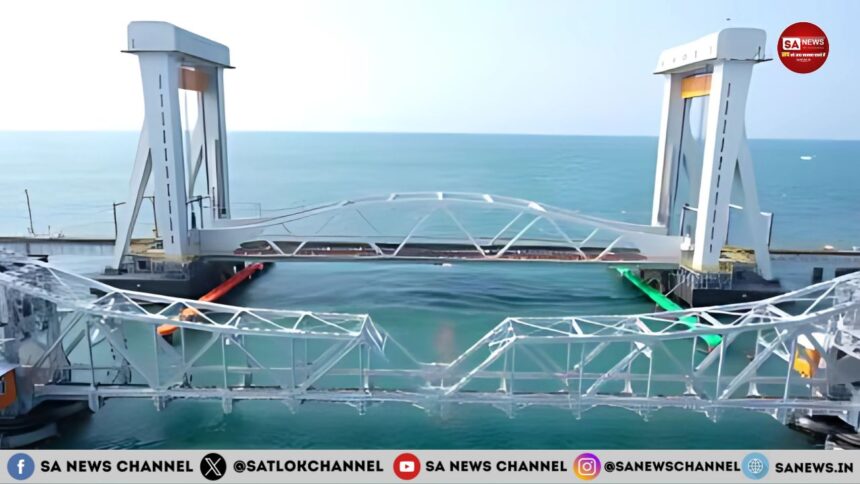India witnessed a historic moment on April 6, 2025, as Prime Minister Narendra Modi inaugurated the iconic Pamban Bridge, a stunning blend of engineering brilliance and cultural reverence. Built to replace the century-old structure, the new Pamban Bridge marks a significant leap in modern infrastructure in India, redefining connectivity between Rameswaram and the mainland.
Let’s explore how this architectural marvel not only strengthens transportation but also deepens our bond with heritage.
The Legacy of the Pamban Bridge
The original Pamban Bridge, commissioned in 1914, was India’s first sea bridge, stretching across the shimmering waters of the Palk Strait to link Rameswaram island to mainland Tamil Nadu. For over a century, it served as a vital lifeline, especially for pilgrims traveling to the sacred Ramanathaswamy Temple and other sites connected to the Ramayana and the legendary Ram Setu.
However, with growing demand and evolving safety standards, the old bridge faced operational limitations. Its mechanical lifting span, though innovative for its time, could no longer handle increased rail traffic and larger maritime vessels. A modern solution was long overdue—and it has finally arrived.
Features of the New Pamban Bridge
The new Pamban Bridge is nothing short of an engineering marvel in Tamil Nadu, boasting cutting-edge features that elevate it to world-class standards. Here are some of its most impressive highlights:
- India’s First Vertical Lift Sea Bridge: The bridge features a vertical lift span—a pioneering design in India. This mechanism allows ships to pass underneath without halting train operations, ensuring seamless transport on both land and sea.
- Massive Scale: Spanning 2.08 kilometers, the bridge is longer, wider, and sturdier than its predecessor.
- Advanced Materials: Built using stainless steel reinforcements and anti-corrosion coatings, it is designed to withstand extreme marine conditions and saline winds.
- Future-Proof Design: With provisions for dual railway tracks, the bridge can accommodate higher traffic volumes, making it ready for future expansion.
- Longevity Assured: The bridge is engineered to last at least 100 years, emphasizing sustainability and long-term planning.
- ₹550 Crore Investment: The total construction cost reflects the government’s commitment to top-tier infrastructure.
PM Modi’s Inauguration Ceremony
The Pamban Bridge inauguration highlights reflected both grandeur and grace. The ceremony was especially significant as it took place on Ram Navami, a sacred day that underscores the spiritual legacy of Rameswaram.
PM Modi arrived amid traditional welcome chants and addressed the nation, calling the bridge a “symbol of New India where tradition meets transformation.” In a moment filled with national pride, he flagged off the Rameswaram-Tambaram Express, the first train to cross the newly built bridge—marking a new era of mobility.
After the inauguration, the Prime Minister also visited the Ramanathaswamy Temple, reiterating his commitment to preserving India’s spiritual heritage while steering its technological advancement.
Impact on Connectivity and Development
The new Pamban Bridge is more than just steel and concrete—it’s a transformative link for thousands of lives.
- Boost to Tourism: Easier and faster connectivity will likely increase footfall to Rameswaram, benefiting local tourism, businesses, and hospitality sectors.
- Improved Trade Routes: Enhanced infrastructure will facilitate smoother transport of goods, stimulating regional commerce and reducing transit times.
- Empowering Local Communities: Better access to markets, healthcare, and education will uplift the socio-economic conditions of nearby villages and towns.
- Strengthening National Integration: As part of a broader vision, projects like this enhance India’s internal connectivity, vital for balanced regional development.
Engineering Marvel and Global Recognition
The construction of the new Pamban Bridge incorporated state-of-the-art engineering practices, including:
- Collaboration with experts from IIT Madras and leading international firms.
- Use of hydraulic modeling to perfect the vertical lift system.
- Application of digital monitoring tools for real-time tracking during construction.
The project has already attracted attention from global engineering forums, positioning India as a leader in innovative infrastructure development. It’s being lauded as a benchmark for future bridge constructions, both in terms of technology and cultural integration.
Conclusion
The inauguration of the new Pamban Bridge by PM Modi is a landmark moment in India’s journey toward modern, resilient infrastructure. It stands as a proud testament to India’s engineering capabilities, while also honoring the spiritual and cultural ethos of the land it connects.
As the trains begin to roll over its majestic span, and ships glide beneath its towering lift, the bridge silently tells a story—of legacy, of innovation, and of a nation moving confidently toward the future.
Bridge of Satgyan: A Spiritual Perspective Inspired by Sant Rampal Ji Maharaj
As India celebrates the inauguration of the New Pamban Bridge, a marvel of modern engineering, it reflects a deeper truth in the spiritual realm. Just as the bridge connects the mainland to Rameswaram, Sant Rampal Ji Maharaj’s Satgyan (true spiritual knowledge) connects the soul to the Supreme God, Kabir Saheb.
While the bridge helps overcome physical obstacles like the sea, Satgyan helps us cross the vast ocean of ignorance, illusion, and sin. The train running on this bridge marks a journey of progress—just as a soul begins its journey to salvation when it embraces the eternal truth revealed by a True Saint.
The Pamban Bridge is a symbol of India’s physical development, but the Bridge of Satgyan is the true path to spiritual liberation. Without it, the soul remains lost. With it, the soul reaches Satlok—the eternal abode
Let’s live this union of progress and heritage, and take pride in how far we’ve come.









